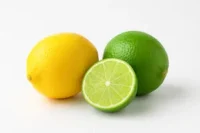Mastering the Art of Growing Sweet Peas: A Comprehensive Guide
Published: 21 Apr 2024
Growing sweet peas from seed is a rewarding process that allows you to witness the entire lifecycle of these enchanting plants. Sweet peas are edible pods of the pea plant, commonly grown in gardens or farms for human consumption. They are harvested when they are fully mature and the outer shell turns bright green or yellow.
Sweet peas are a popular choice for companion planting due to their ability to fix nitrogen levels in the soil, which benefits nearby plants like tomatoes, peppers, and squash. Scottish nurseryman Henry Eckford (1823–1905) cross-bred and developed the sweet pea, turning it from a rather insignificant, sweetly scented flower into a floral sensation of the 19th century.
Sweet peas, or Lathyrus odoratus, are low in calories, fat-free, and high in fibre and protein, making them a healthy addition to a balanced diet. They can be eaten raw or cooked and are often used in soups, stews, and stir-fries.
They originated from the Aegean Islands and were first introduced to gardening in the 17th century. This article teaches you how to grow sweet peas easily for a bountiful harvest.
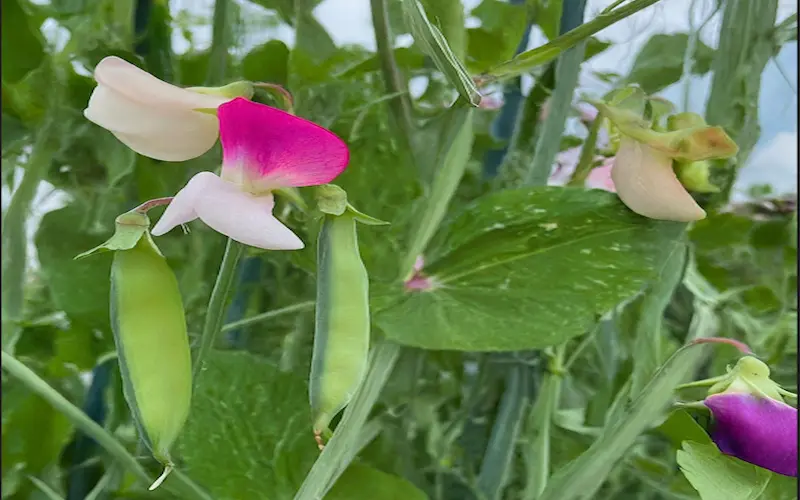
| Benefits of Growing Sweet Peas |
|---|
It has many benefits.
|
Choosing the Right Variety
The key to a successful sweet pea garden is selecting the appropriate variety. The choices can be overwhelming, with hundreds of cultivars offering their own colour, pattern, and scent profile. I’ve learned to consider several factors when choosing the sweet pea variety for my garden.
Firstly, it’s essential to identify the purpose of your sweet pea plants. Are you looking for vibrant climbers to adorn a trellis, or are you seeking compact varieties suitable for containers? This will guide your selection process. For example, Spencer and Grandiflora types are known for their long stems and are ideal for cut flowers, while dwarf varieties like the ‘Cupid’ are perfect for growing in pots or hanging baskets.
Another consideration is the flowering season. Some sweet peas are early bloomers, while others flower later in the season. To ensure a continuous display, I choose a mix of varieties that will bloom at different times. Additionally, climate plays a significant role in your choice. Certain varieties are more tolerant of heat, while others prefer cooler temperatures. Be sure to select a variety that will thrive in your local conditions.
Lastly, remember the visual and olfactory impact. Sweet peas come in various colors, from pastels to deep, saturated hues. Select colors that complement your garden’s palette. The fragrance is equally important, as it is one of the sweet pea’s most delightful features. Some varieties have a more pungent scent than others, so if fragrance is a priority, opt for those known for their aromatic blooms.
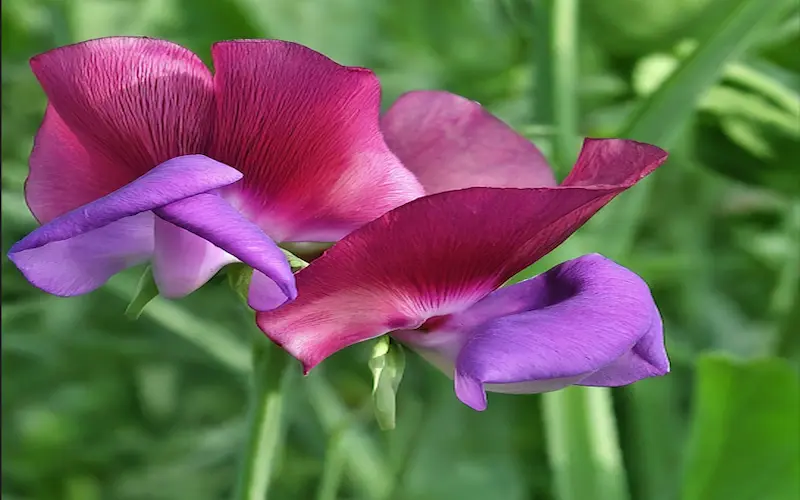
Preparing the Soil for Sweet Peas
Preparing the soil before sowing or planting sweet pea seedlings is crucial to ensuring your plants’ success. Sweet peas thrive in well-drained, fertile soil with a neutral to slightly alkaline pH. I start by testing the soil where I plan to plant my sweet peas to understand what amendments may be necessary.
To improve soil structure and fertility, I incorporate plenty of organic matter, such as well-rotted manure or compost, into the soil a few weeks before planting. This enriches the soil and improves drainage, which is essential to prevent waterlogging and root rot. Sweet peas have deep root systems, so I work the soil at least a foot deep to allow for proper root development.
Adding a balanced, slow-release fertilizer to the soil before planting is also beneficial. This will provide a steady supply of nutrients throughout the growing season. However, avoiding high-nitrogen fertilizers is important, as they can encourage more foliage growth at the expense of flowers. Once the soil is prepared and the last frost date has passed, it’s time to move on to the planting stage.
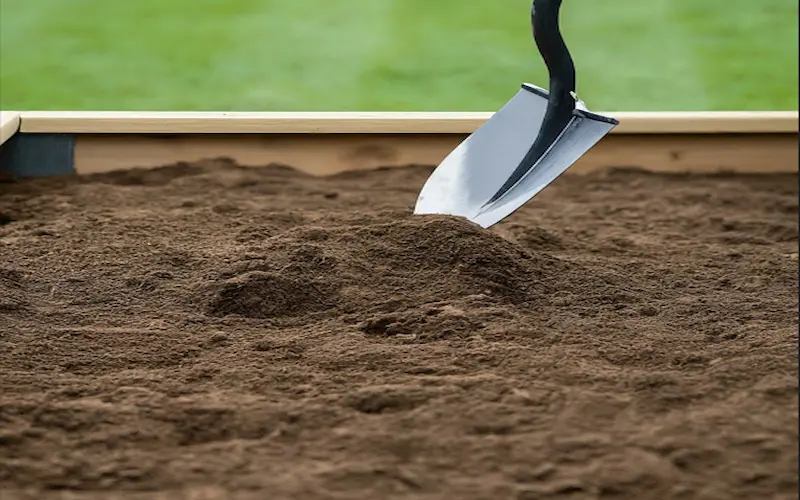
How to Grow Sweet Peas from Seed
I select high-quality seeds and soak them in water for 24 hours before planting. This softens the seed coat and speeds up germination. Some gardeners also recommend nicking the seeds with a nail file to facilitate water absorption.
When sowing the seeds, I prefer to start them indoors 6-8 weeks before the last frost date. This gives the seedlings a head start and ensures vigorous, healthy plants are ready for transplanting when the weather warms up. I use biodegradable pots filled with seed-starting mix to avoid disturbing the roots during transplanting. Sow the seeds about an inch deep, water them well, and keep the soil moist but not waterlogged.
For those who live in milder climates, direct sowing into the garden can be done as soon as the soil is workable. I space the seeds about 2-3 inches apart and thin the seedlings once they reach about 2 inches in height. This ensures that each plant has enough space to grow and develop a robust root system. With proper care, it won’t be long before the first sweet pea sprouts appear, signalling the start of an exciting growing season.
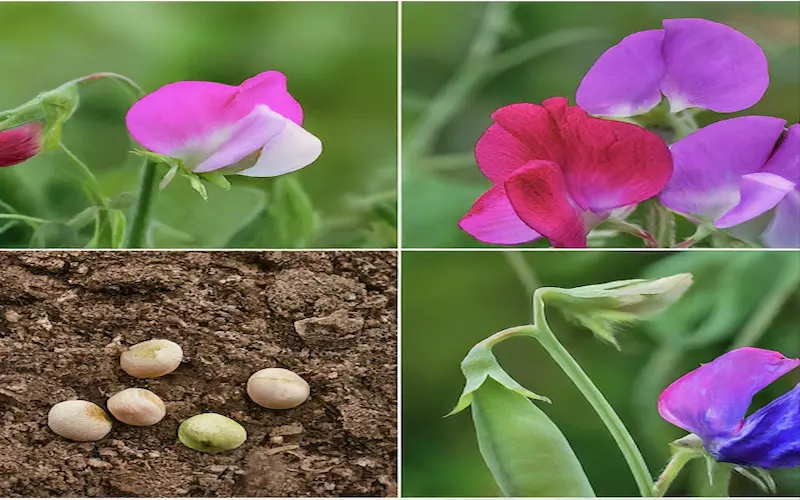
Caring for Sweet Peas in Pots
Sweet peas are versatile and can thrive in containers, making them an excellent choice for those with limited garden space or who prefer the flexibility of pot gardening. When learning how to grow sweet peas in pots, I focus on choosing the correct container, providing ample support, and maintaining proper care.
The container should be 12 inches deep to accommodate the sweet pea’s long roots and have adequate drainage holes to prevent waterlogging. I use a high-quality potting mix, which ensures good aeration and drainage, and I mix in a slow-release fertilizer to support growth. Keeping the soil consistently moist is crucial, as potted plants tend to dry out faster than ground ones.
Support is essential for sweet peas, even in pots. I use a small trellis or obelisk within the container to give the plants something to climb on as they grow. This helps the sweet peas develop properly and adds an architectural element to the pot display. Regular deadheading of spent flowers is also necessary to encourage continued blooming and prevent the plants from going to seed too early in the season.
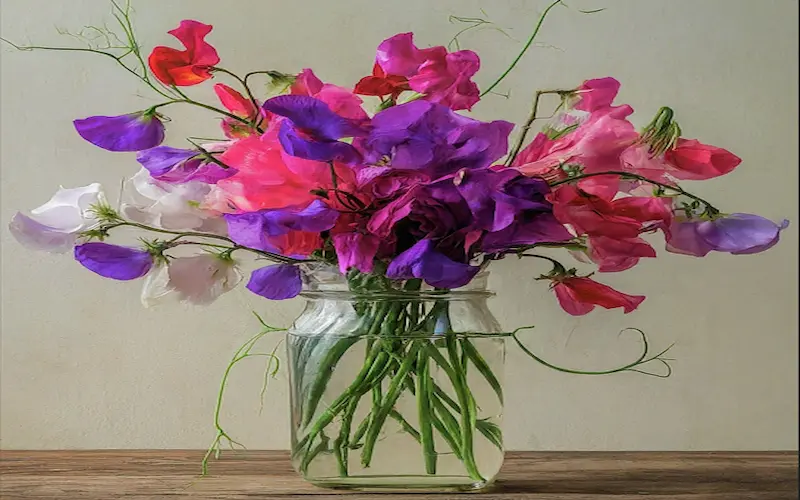
Supporting and Training Sweet Peas
Proper support and training are vital to the health and appearance of sweet peas. These plants are natural climbers and require a structure to twine around as they grow. I’ve found that the most effective supports are sturdy and have a grid or netting that the tendrils can quickly grasp.
In my garden, I use a variety of supports, including trellises, obelisks, and even strings stretched between poles. When planting, I place the supports in the ground to minimize later disturbance to the roots. As the sweet peas grow, I gently guide the tendrils onto the support and encourage them to twine around it. This keeps the plants upright and healthy and creates a visually appealing display.
Training sweet peas is a continuous process throughout the growing season. I regularly check the plants and help stray tendrils reach the support. This keeps the garden tidy and ensures the plants receive adequate air circulation, which is essential for preventing disease. With the proper support and a bit of training, sweet peas will climb eagerly and produce an abundance of blooms.
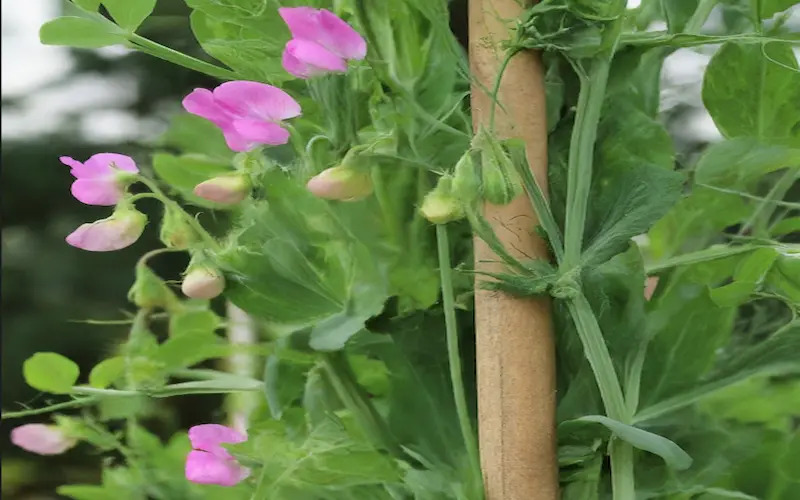
Common Problems and Solutions to Growing Sweet Peas
Like all plants, sweet peas can encounter various problems during their growing season. The most common issues include pests, diseases, and cultural problems such as improper watering or nutrient deficiencies. My approach to managing these challenges is to be vigilant and proactive.
Pests such as aphids and spider mites can be deterred by regularly inspecting the plants and using organic control methods like insecticidal soaps or neem oil. Diseases such as powdery mildew and root rot often result from too much moisture or poor air circulation. I ensure proper spacing, avoid overhead watering, and apply fungicides if necessary to prevent these.
Nutrient deficiencies can manifest as yellowing leaves or poor flowering. I address this by applying a balanced fertilizer and ensuring the soil pH remains neutral to slightly alkaline. If the plants appear to be producing more foliage than flowers, I reduce the nitrogen level in my fertilizing regime to encourage blooming.
By promptly addressing these common problems, I can maintain the health and vitality of my sweet peas, ensuring a bountiful and beautiful display throughout the growing season.
Harvesting and Preserving
The best time to cut sweet pea flowers is early morning when the blooms are freshly opened. I use sharp scissors to cut the stems just above a leaf joint, encouraging new growth and more blooms. Regularly cutting flowers for bouquets not only brings the beauty and fragrance of sweet peas indoors but also prolongs the blooming period of the plants.
To preserve the harvested sweet pea flowers, I immediately place them in a vase of clean water with a floral preservative. This helps to keep them fresh and vibrant for longer. For those who wish to save sweet pea seeds for the next planting season, I allow some of the pods to mature on the plant until they turn brown and begin to crack open. Then, I collect the seeds and store them in a cool, dry place until it’s time to plant them again.
Sweet peas can also be dried for use in crafts or decorations. To do this, I hang bunches of flowers upside down in a dark, well-ventilated area until completely dry. This way, I can enjoy the charm of sweet peas even after the growing season has ended.
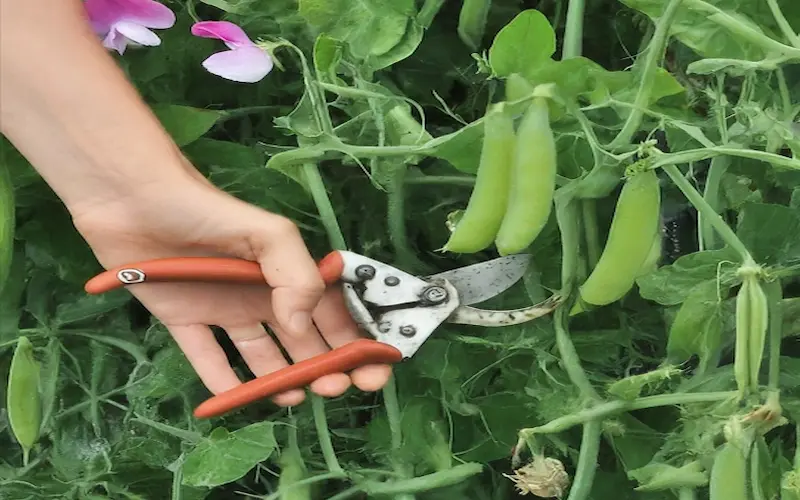
Conclusion
Growing sweet peas is a delightful journey that brings colour, fragrance, and life to the garden. From selecting the suitable variety to providing proper care and support, each step is an opportunity to engage with the natural world and cultivate beauty. Reflecting on how to grow sweet peas, I am reminded of the joy and satisfaction of watching these exquisite climbers thrive under my care.
I encourage you to embark on your sweet pea adventure. Embrace the process, anticipate the challenges, and revel in the beauty of these extraordinary flowers.

- Be Respectful
- Stay Relevant
- Stay Positive
- True Feedback
- Encourage Discussion
- Avoid Spamming
- No Fake News
- Don't Copy-Paste
- No Personal Attacks



- Be Respectful
- Stay Relevant
- Stay Positive
- True Feedback
- Encourage Discussion
- Avoid Spamming
- No Fake News
- Don't Copy-Paste
- No Personal Attacks


